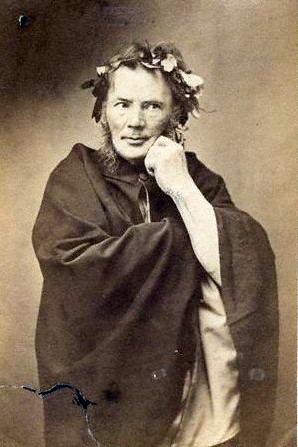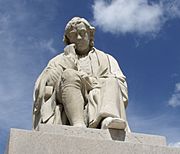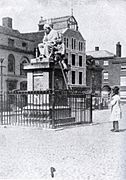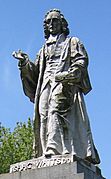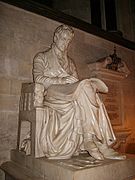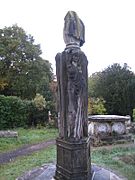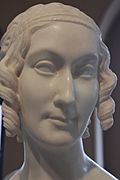Richard Cockle Lucas facts for kids
Quick facts for kids
Richard Cockle Lucas
|
|
|---|---|
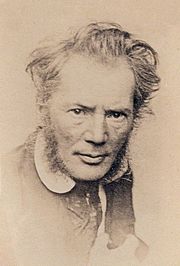
Self-portrait, circa 1858
|
|
| Born | 24 October 1800 Salisbury, Wiltshire
|
| Died | 18 May 1883 (aged 82) Chilworth, Hampshire
|
| Nationality | British |
| Known for | Sculptor, photographer |
| Spouse(s) | Eliza |
| Children | Albert Dürer Lucas |
Richard Cockle Lucas (born October 24, 1800 – died May 18, 1883) was a talented British artist. He was known for creating sculptures and also for his photography.
Contents
Becoming a Sculptor and Artist
Richard Cockle Lucas was born in Salisbury, Wiltshire. His father was also named Richard Lucas, and his mother was Martha Sutton. Sadly, his mother passed away shortly after he was born.
When Richard was just twelve years old, he started working for his uncle. His uncle was a cutler, which means he made and sold knives and other cutting tools, in Winchester. It was here that Richard showed his amazing skill. He was very good at carving knife handles, which proved he had a natural talent for sculpting.
At 21, he moved to London to study art. He attended the Royal Academy Schools, a famous art school. From 1828 onwards, he often showed his artwork at the Royal Academy. He even won silver medals for his architectural drawings in 1828 and 1829.
Family Life and Moving Home
Richard's son, Albert Dürer Lucas, was born in 1828 in Bayswater, London. By 1846, the family was living in central London. In 1849, they moved out of the city. They went to Otterbourne, near Winchester, possibly for health reasons. While there, Richard might have become friends with Charlotte Mary Yonge, a well-known children's author from the Victorian era.
Around 1854, Lucas moved again to Chilworth, near Romsey. He designed and built a unique house there called the "Tower of the Winds." Later, in 1865, he built a second home nearby, which he named "Chilworth Tower."
An Eccentric Artist
As he got older, Richard Lucas became quite unusual. He believed in fairies and was known for riding around Southampton in a Roman chariot!
Richard Lucas showed more than a hundred of his artworks at various exhibitions. These included the Royal Academy, the British Institution, and the Suffolk Street Gallery. His works included busts (sculptures of a person's head and shoulders), medallions (small, round sculptures), and pieces based on classical stories.
Some of his larger statuary (statues) include those of Samuel Johnson in Lichfield, Isaac Watts in Southampton, and Richard Colt Hoare in Salisbury Cathedral. While these large works were impressive, he was especially good at making smaller, detailed pieces.
His medallion portraits, made from marble, wax, and ivory, were very popular. Many were shown at the Great Exhibition, a huge event in London in 1851. The National Portrait Gallery even bought several of them. You can also find some of his wax medallions at Bodelwyddan Castle. These include portraits of famous people like Sir Frederic Madden and Anthony Panizzi. The National Portrait Gallery also has two self-portraits of Lucas.
Famous Works and Studies
One of Lucas's well-known wax reliefs is Leda and the Swan. This piece was bought by the Victoria and Albert Museum in London. Another copy is in the National Gallery, Berlin. The Victoria & Albert Museum also has a bust of Catherine, Lady Stepney, a famous London hostess, shown as Cleopatra.
Lucas was very interested in the Elgin Marbles, which are ancient Greek sculptures. He made two large wax models of the Parthenon, the temple where the marbles came from. One model showed the Parthenon after it was damaged in 1687. The other showed how he thought the sculptures originally looked. This model was displayed at the British Museum and got a lot of attention. In 1845, he wrote a book called Remarks on the Parthenon, which included his own etchings (prints made from metal plates).
Richard Lucas also created many etchings. These prints showed his own sculptures, stories from the Bible, and scenes from 18th-century poems. He even made an album of these etchings, which he bound himself. He also created "cartes de visite" (small photographs) of himself. These photos showed him in different dramatic poses, highlighting his unique personality.
Towards the end of his life, Lucas was a frequent guest at Broadlands, the home of Lord Palmerston, a very important politician. Lord Palmerston helped him get a special pension in 1865. Lucas made three wax portraits of Palmerston and a small statue, which was his last artwork shown at the Royal Academy in 1859. In 1870, he published a book called An Essay on Art.
The Mystery of the Flora Bust
One of the most interesting stories about Richard Cockle Lucas involves a sculpture called the bust of Flora. This bust was bought by the Kaiser Friedrich Museum in Berlin. The museum believed it was made by the famous artist Leonardo da Vinci.
Wilhelm von Bode, who managed the Prussian Art Collections for the Berlin Museum, saw the bust in a London art gallery. He bought it for a very high price. Bode was sure it was by Leonardo, and everyone in Berlin was thrilled. They felt they had "snatched a great art treasure" from the British art world.
Solving the Mystery
However, in 1910, Albert Dürer Lucas, Richard Cockle Lucas's son, said that his father had actually created the sculpture. Soon after, The Times newspaper published an article supporting this claim. It said that Lucas had been asked to make the bust based on a painting.
Albert then officially swore that his story was true. He even explained how he helped his father make the sculpture. He described how they built up the layers of wax using old candle ends. He also said that his father would put different things, like old newspapers, inside the bust. When the Berlin museum staff checked, they found exactly what Albert described, including a letter from the 1840s!
Despite this clear evidence, Wilhelm von Bode continued to insist that the bust was by Leonardo. To try and prove his point, he displayed the Flora bust alongside other works by Lucas. But this plan didn't work out as he hoped. The exhibition actually showed that Lucas often made wax sculptures that looked like famous artworks from the past.
A London art critic named Paul George Konody especially fought against Dr. Bode's claims in the London Daily Mail newspaper. Many different ideas have been suggested about the bust. Some thought it was a complete fake, while others believed it was a real 16th-century piece, just not by Leonardo.
In April 2021, scientists used a method called carbon-14 dating to find out the bust's age. This test confirmed that it was indeed sculpted in the 19th century, during Lucas's time. Today, the bust is still on display in what is now the Bode Museum. It is labeled "England," "19th Century," with a question mark, acknowledging its mysterious past.
Richard Lucas's Later Life and Passing
Richard Lucas passed away from paralysis at his home in Chilworth on May 18, 1883. He left behind his wife, Eliza, and his son, Albert Dürer Lucas.
His son, Albert Dürer Lucas (1828–1918), also became an artist. He was known for painting still-life scenes and flowers. Albert's paintings were shown at the British Institution and with the Society of Artists between 1859 and 1874. His artworks are still often copied and sold today.
Where to See Richard Lucas's Works
Besides the pieces in museums and the large statues, you can find many of Richard Lucas's works in churches and other public places. Here are a few examples:
- The Robert Pearce family grave in Southampton Old Cemetery. This memorial features sculptures of Faith, Hope, and Charity. It is considered a historically important site.
- A wax relief of Thomas Burgess (1756–1837), who was a Bishop of Salisbury. This artwork is displayed at the University of Wales, Lampeter.
- A portrait tablet for John Willis Fleming (1781–1844) in St. Nicolas' Church, North Stoneham, near Southampton.
- A reclining statue of Count Jerome de Salis-Soglio (1771–1836) in St. Mary's church, Harlington, West London.
- The statue of Richard Colt Hoare in Salisbury Cathedral (made in 1841).
- The statue of Isaac Watts in Southampton (made in 1858).
See also
- Article on German Wikipedia "Wachsbüste der Flora (Wax bust of Flora)"
Gallery
- Monuments sculpted by Richard Cockle Lucas
-
Statue of Dr. Samuel Johnson in Market Square, Lichfield
-
Statue of Isaac Watts in the West (Watts) Park in Southampton
-
Monument to Sir Richard Colt Hoare in Salisbury Cathedral
-
Pearce family grave in Southampton Old Cemetery
-
Catherine, Lady Stepney, Victoria and Albert Museum.


